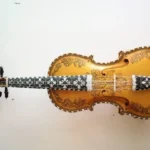
The tabla, a percussion instrument steeped in the rich heritage of Indian classical music, stands as a testament to the rhythmic heartbeat of a cultural legacy. With ancient origins and a journey through centuries, the tabla has evolved into a versatile and expressive instrument, transcending borders and genres. From its integration into classical music to collaborations with global musicians, the tabla’s beats have echoed through time, leaving an indelible mark on the world’s musical tapestry. Join us on a rhythmic exploration as we uncover the historical nuances, virtuoso performances, and cultural significance that define the soulful journey of the tabla.
Ancient Origins: The tabla’s roots delve into the rich tapestry of ancient Indian music, where it evolved from a variety of hand and barrel-shaped drums present in diverse regional traditions. These early percussion instruments laid the foundation for the development of the tabla as a distinct and refined instrument, showcasing the deep historical connection between Indian music and its rhythmic elements.
Classical Music Integration: Around the 18th century, the tabla became an indispensable component of classical Indian music, particularly in the Hindustani classical tradition. Its integration was a watershed moment, transforming the landscape of classical compositions and providing a rhythmic anchor for intricate melodic and vocal expressions.
Creation of the Modern Tabla: Credited to the musical genius Amir Khusrau in the 13th century, the modern form of the tabla represents a fusion of diverse drumming traditions. Khusrau’s innovations in design and tuning laid the groundwork for the distinctive two-drum structure, defining the tabla as we recognize it today.
Two-Part Drum: The fundamental design of the tabla consists of two drums, each serving a specific purpose. The smaller drum, known as the “dayan,” is played with the dominant hand and produces sharp, resonant tones. In contrast, the larger drum, the “bayan,” is played with the non-dominant hand and generates deeper bass tones. The synergy between these two drums allows for a nuanced and expressive range of sounds.
Construction Materials: Traditional tablas are crafted with meticulous attention to materials. The wooden body provides structural integrity, while the playing surfaces are traditionally covered with animal hide, usually from goats. Leather straps secure the hides in place, emphasizing the artisanal craftsmanship integral to the instrument’s construction.
Tuning and Pitch: Tabla players possess the ability to adjust the pitch of each drum, offering a dynamic range of tones. This tuning process involves applying pressure to the drumhead or using a tuning hammer to tighten or loosen the leather straps. This capacity for fine-tuning contributes to the tabla’s adaptability to various musical contexts.
Tabla Maestro Zakir Hussain: Zakir Hussain, a tabla virtuoso of unparalleled skill, has played a transformative role in the global appreciation of the instrument. His remarkable talent, innovative compositions, and collaborations with renowned musicians have not only elevated the tabla to new heights but have also transcended cultural boundaries, making him a luminary in the world of percussion.
Tala System: Central to the rhythmic intricacies of tabla playing is the “tala” system. Tala structures time in a cyclic pattern, dictating the rhythm of a performance. This sophisticated rhythmic cycle, guided by a set number of beats and subdivisions, forms the foundation for improvisation and intricate rhythmic patterns.
Influence on World Music: Beyond its roots in classical Indian music, the tabla has left an indelible mark on world music. Its rhythmic patterns and expressive capabilities have found resonance in diverse genres, influencing artists globally and contributing to the multicultural tapestry of contemporary music.
Tabla in Film Music: The tabla has played a pivotal role in the cinematic realm, enhancing the emotional and rhythmic dimensions of Indian film music. Composers and music directors have utilized the tabla’s versatility to evoke a range of moods, making it an integral part of the sonic landscape in Indian cinema.
Invention of the Bayan: A notable development in the tabla’s evolution occurred in the early 20th century with the addition of a fifth string to the bayan, the larger drum. This innovation expanded the range of tones available to tabla players, allowing for greater expressiveness and versatility in performances. The introduction of the fifth string marked a pivotal moment in the instrument’s ongoing development and refinement.
Pandit Ravi Shankar and Ustad Alla Rakha: The collaboration between sitar virtuoso Pandit Ravi Shankar and tabla maestro Ustad Alla Rakha in the 1960s was a landmark in the global popularization of Indian classical music. Their collaborations, including performances at iconic events like the Woodstock Festival, introduced audiences worldwide to the mesmerizing synergy between the sitar and tabla, elevating both musicians to international acclaim.
Gharana Tradition: The tabla is passed down through the gharana tradition, a lineage-based system where students learn from a master (guru) within a specific school of tabla playing. Each gharana, such as Delhi, Ajrara, Benares, and Punjab, imparts unique playing styles, techniques, and compositions, contributing to the diverse tapestry of tabla playing.
Tabla Syllables: The sounds produced on the tabla are represented by specific syllables, known as “bols.” Each syllable corresponds to a specific stroke or combination, helping players communicate and notate complex rhythmic patterns. Syllables such as “na,” “ge,” “ke,” and “dha” form the rhythmic language that tabla players use to create intricate compositions.
Role in Conservation: Tabla festivals, such as the Delhi International Tabla Seminar and the Pune Festival, play a vital role in celebrating and preserving the art of tabla playing. These events provide a platform for artists to showcase their skills, fostering a sense of community among tabla enthusiasts and contributing to the continued vibrancy of the art form.
Feather Trade: The tabla’s intricate craftsmanship and use of natural materials, including animal hides for drumheads, have historically raised ethical concerns related to the use of wildlife resources. The demand for high-quality hides has, at times, led to the exploitation of wildlife, prompting discussions about sustainable practices and alternatives.
Protected Status in India: Recognizing the cultural and historical significance of the tabla, India has taken steps to protect and promote its traditional musical instruments. The tabla, as a symbol of the nation’s musical heritage, enjoys recognition and support through cultural preservation initiatives.
Avadhoot Bhise’s Contribution to Tabla Notation: Avadhoot Bhise, an accomplished tabla player and musicologist, made significant contributions to the development of a standardized notation system for tabla compositions. His efforts in creating a universally accepted notation system have facilitated the documentation and transmission of tabla compositions.
Electronic Tabla: The late 20th century witnessed the advent of electronic tablas, providing modern alternatives for musicians. These electronic versions offer features such as adjustable volume, a variety of sounds, and portability, expanding the tabla’s reach into contemporary music genres and modern recording environments.
Tabla Notation System: Tabla compositions are often notated using a specific system that employs symbols and characters to represent the various strokes and rhythms. This notation system facilitates the transmission of compositions through written form, enabling students and musicians to learn and preserve traditional compositions.
Historical Impact on Riparian Areas: The tabla’s influence on riparian areas might not be a literal one, but metaphorically, it has undeniably created rhythmic waves across the musical landscape. The historical impact of the tabla extends beyond physical ecosystems, as it has shaped the auditory environment of classical Indian music. Its rhythmic patterns, akin to the flow of water, have metaphorically enriched the cultural and artistic landscapes where the tabla finds its rhythmic expression.
Historical Restoration Efforts: The concept of “restoration” in the context of tabla is metaphorically relevant, reflecting the continuous efforts to preserve and revive traditional playing styles, compositions, and the essence of classical music. Musicians and institutions engage in historical restoration, ensuring that the tabla’s heritage remains vibrant and authentic despite evolving musical landscapes.
Historical Plant Morphology Studies: While not applicable to the tabla, the analogy of “plant morphology studies” can be likened to the detailed exploration of tabla construction and design. Scholars and craftsmen delve into the intricacies of the instrument’s physical structure, akin to botanists studying plant forms, contributing to a comprehensive understanding of the tabla’s anatomy.
Historical Ecological Changes: The historical spread and evolution of tabla playing styles can be metaphorically likened to ecological changes. Different playing techniques, innovations, and the introduction of new compositions represent the ever-changing dynamics within the tabla ecosystem. The historical narrative of the tabla mirrors the adaptability and resilience observed in ecosystems undergoing gradual transformations.
Historical Herbicidal Applications: The concept of “herbicidal applications” metaphorically aligns with attempts to weed out undesirable elements and preserve the authenticity of the tabla tradition. Scholars, teachers, and practitioners metaphorically apply “herbicides” by addressing challenges like dilution of traditional styles or commercialization, ensuring the tabla’s cultural roots remain robust and unadulterated.








